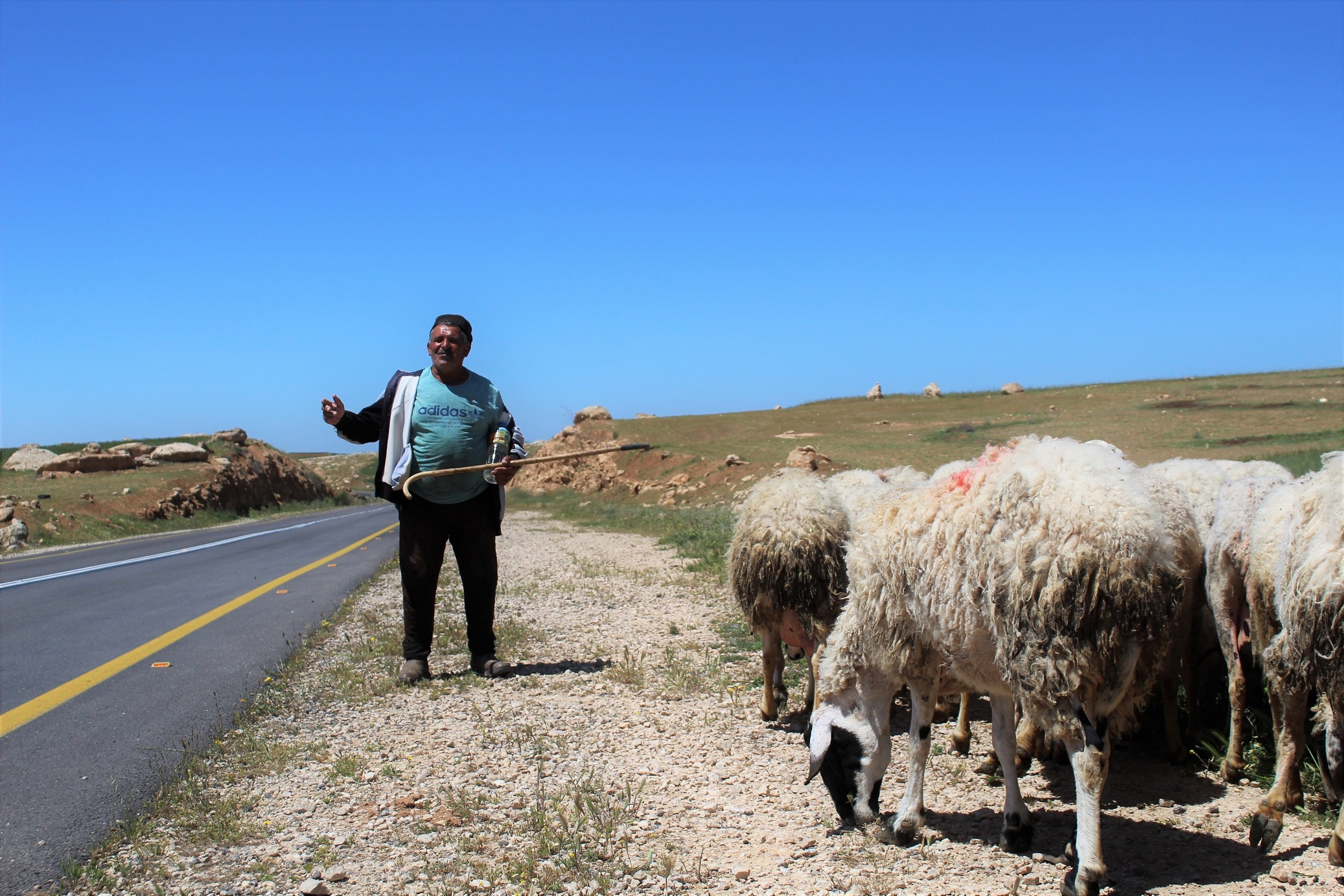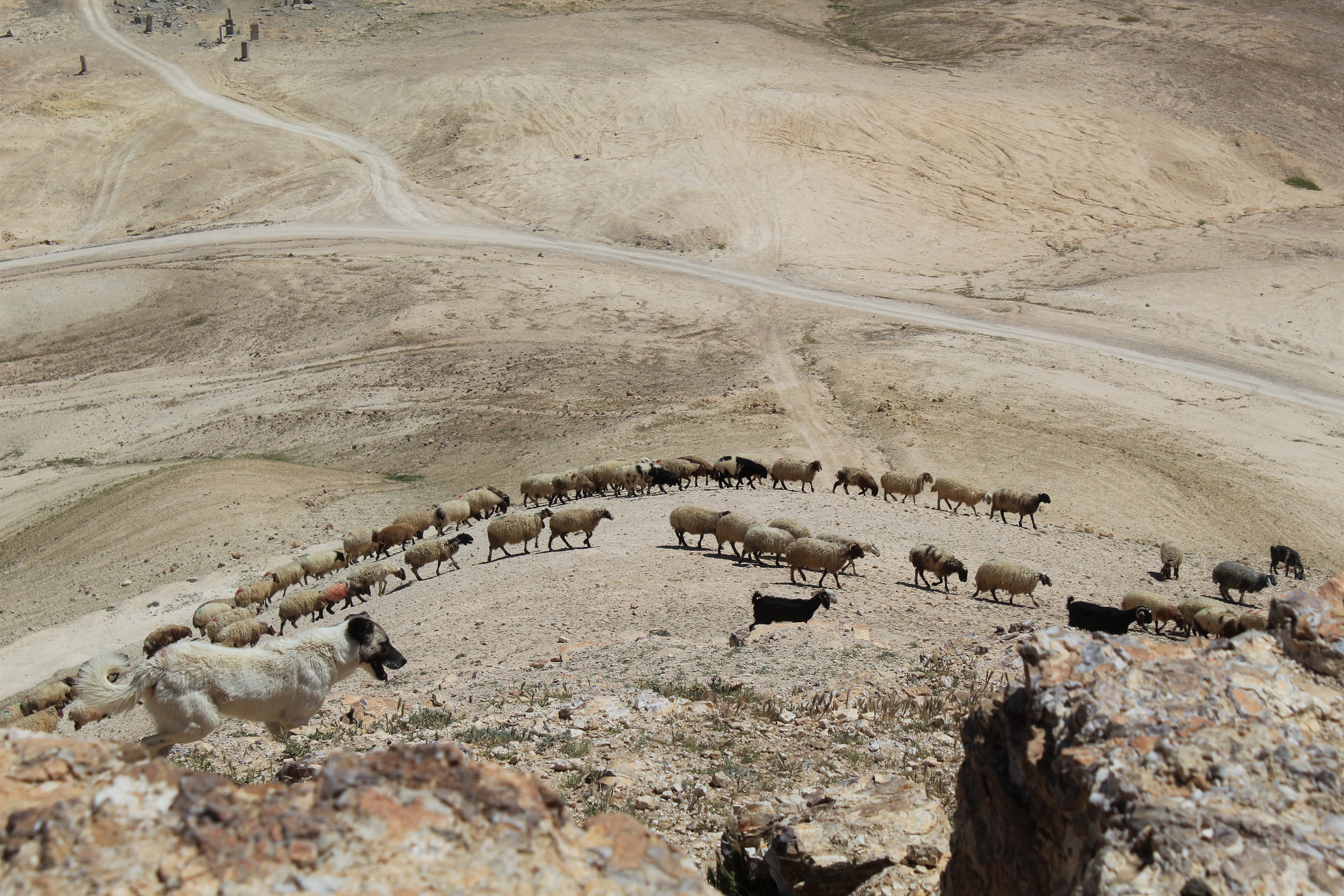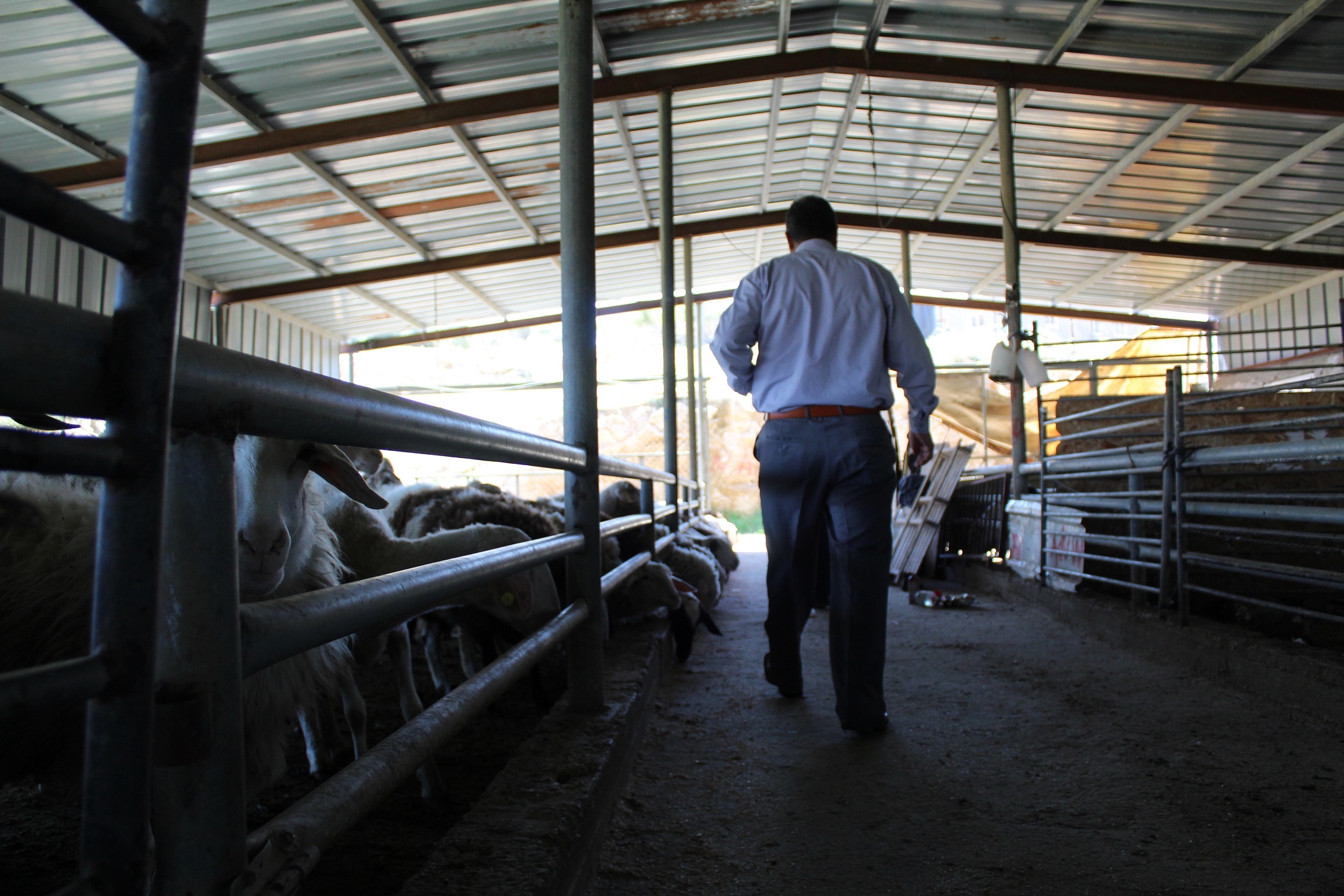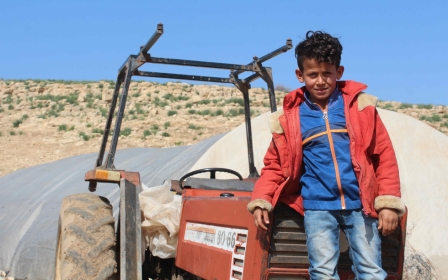Hebron farmers struggle for existence in face of climate change

Bahjat Jabarin stands on a large hill with a local Bedouin farmer, Hassan Basayta, surveying the parched slopes of the Hebron hills. The view is partially blocked by an old Israeli military base adorned with graffiti.
"Now we are in the middle of spring and you can see [only] desert," says Jabarin, director of the Palestinian Environment Quality Authority (EQA) office in Hebron.
Hassan Basayta, known as Abu Zeyad, is the local council head of four Bedouin communities - Azwadeen, Al Najada, Um al Kheir, and Khashm Aldaraj - in what is called the Eastern Slope, an area east of Yatta city under the Hebron governorate.
One of five climate and geographical belts in historic Palestine, the Eastern Slope is also the region in the West Bank most affected by climate change.
New MEE newsletter: Jerusalem Dispatch
Sign up to get the latest insights and analysis on Israel-Palestine, alongside Turkey Unpacked and other MEE newsletters
A cross between arid and semi-humid highlands, the area is more susceptible to desertification and fluctuation in annual rainfall, amplifying existing water scarcity conditions due to climate change and the illegal Israeli military occupation.
Fleeing desertification
"Thirty years ago, we were fully dependent on grazing for our animals, without supplementary feed," says Abu Zeyad, adding that the Bedouin communities in the area are fully engaged in the agricultural sector through livestock raising and breeding.
Now, with increasing aridity and restricted access of range land, livestock owners and breeders are "100 percent" dependent on "spoon-feeding" their animals with costly feed that comes from outside of Palestine.
According to Jabarin, the EQA director, two-thirds of the Bedouin communities have migrated away from the area, seeking water resources and grazing land.
Most moved to the north of the West Bank, where it is cooler and they can continue raising livestock. But others were forced to leave the practice altogether and look for alternative income sources.
Witnessing hundreds of goats and sheep forlornly grasp at the last remaining shrubbery in a dry land makes the effects of climate change in the Eastern Slope palpable.
Yet when asked what the biggest challenge he has in maintaining his agricultural lifestyle as a Bedouin, Abu Zeyad insists, "first of all, [it's] the Israeli occupation".
Occupation worsens conditions
The entire Eastern Slope is classified as range land. Before the 1967 war, around 2.3 million dunums (2,300 square km) were "common land" for these tribal communities, Abu Zeyad says.
Since the Israeli occupation of the West Bank in 1967 until about 2005, access to these grazing-only zones was completely prohibited for the local Palestinian population. According to Abu Zeyad, maybe 300,000 dunums, or 30,000 hectares, are left for grazing in the entire West Bank.
Before the 70s in this season it was green. But now, it's just a desert without any species
- Abu Zayed, farmer
Most of this grazing land was confiscated and used as military bases, settlements and training camps. Because of the military use of bulldozers, tanks, and bombs, Abu Zeyad tells MEE, the once fertile layers of the soil have changed forever.
"There are no plants there, although it is the peak of spring," he says. "Before the 1970s, in this season it was green. But now, it's just a desert without any species."
Overgrazing and uprooting of diverse species have been another problem that has ruined animal breeding in the Eastern Slopes forever.
"But what is the cause?" Nayef Basayta (Abu Abdullah), a fellow farmer and tribal leader, asks knowingly. "Two things," he says. "Because of climate change and longer, dryer summer seasons [and] because of land confiscation for [Israeli] military bases, walls, etc."
Land confiscation and movement restrictions imposed on Palestinian farmers by the Israeli occupation decreases areas of range land, Abu Abdullah says. "This all leads to overgrazing in the limited open areas and to desertification."
Water is already scarce in this marginalised climate zone and the Israeli occupation has dramatically made things worse. According to Nedal Katbeh-Bader, the minister adviser on climate change for the EQA, rainfall is expected to decrease by more than 30 percent by the end of the century.
At the same time, "the Israelis are controlling 100 percent of Palestinian water," Katbeh-Bader says. "And more than 82 percent for their [own] purposes," meaning for Israeli use either inside the green line - the pre-1967 border - or on illegal West Bank settlements. The rest they sell back to the Palestinians.
The cost of climate change
Mustafa, a shepherd from the al-Hawamdeh tribe in the village of al-Samoa, tells MEE that everyone in his village needs to purchase tanks of water from the Palestinian municipality, since there is no constructed water network.
Subsidised by the government, each nine-cubic-metre tank costs 150 shekels ($41). "But they don't give us what we need," Mustafa says.
Each tank lasts "from one to one-and-a-half weeks". He can get a tank from the "black market" for about $83, but at that price an agrarian lifestyle is just not economically feasible.
Palestinians in these southern areas of the West Bank also do not have proper wastewater networks, which affects access to natural water resources.
According to Jabarin, the Hebron governorate has 380 registered fresh water springs, but "80 percent are now fully contaminated and are not potable," he says. "According to our Palestinian law, they are not all fit even for agriculture."
Roughly 75 percent of the Bedouin communities in the Eastern Slope depend on livestock farming for their main income. And these people are "very poor and very weak" groups, says Abu Abdullah. "They are far from central government, and employment in other sectors is difficult. You can see the impact on their lifestyle, the way they live."
Since these farmers are now completely dependent on "intensive breeding," meaning non-free range and non-grazing, most of their income goes to feedstuff. One tonne of feedstuff is about $420 per tonne.
"It's not feasible," says Abu Abdullah. Bedouins in the Eastern Slope continue the agricultural practice of livestock breeding "just for our own consumption of daily production."
Neglected zone
"Seventy-five percent of the cost for animal raising goes to feedstuff," Abu Zeyad says. "We save just 25 percent for living," and that is not counting labour costs - his entire 20-person family takes part in the work; if labour costs were included, he would be in the red.
"Breeding is by our ethics and emotions; [it is] not economical," Abu Abdullah says. "From tradition, we have livestock and sheep," which he says is the main reason why these farmers maintain their practice, despite their impoverished conditions.
They are Bedouins, and they strive in order to maintain their way of life
- Bahjat Jabarin
"The economic system is going for the worst," Jabarin says. "It's a marginalised zone [already], and there is not sufficient support from the government."
According to Jabarin, most Bedouin communities throughout the West Bank are dealing with similar problems. In EQA reports on climate change strategies, however, the worst impact is on the eastern zones and the southern part of the West Bank.
"It's a neglected zone, not just during the Palestinian Authority but during the 50 years of Israeli occupation," Jabarin says.
But Bedouins are persistent. Jabarin points out that it is very difficult to change the mentality of Bedouins. "They are Bedouins, and they strive in order to maintain [the Bedouin] way of life," he says.
This article is available in French on Middle East Eye French edition.
Middle East Eye delivers independent and unrivalled coverage and analysis of the Middle East, North Africa and beyond. To learn more about republishing this content and the associated fees, please fill out this form. More about MEE can be found here.







